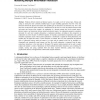Free Online Productivity Tools
i2Speak
i2Symbol
i2OCR
iTex2Img
iWeb2Print
iWeb2Shot
i2Type
iPdf2Split
iPdf2Merge
i2Bopomofo
i2Arabic
i2Style
i2Image
i2PDF
iLatex2Rtf
Sci2ools
IJMMS
2002
2002
Modelling multiple mind-matter interaction
Relations between mental and physical aspects of an agent can be of various types. Sensing and acting are among the more commonly modelled types. In agent modelling approaches often this is the only ion between the physical and mental; other possible types of interactions are abstracted away. If it is also taken into account that the agent's mind has a materialisation in the form of a brain, the relations between mind and matter may become more complex. An explanation of a dynamic pattern may involve mental aspects, physical aspects, and interactions between mental and physical aspects. An explanatory perspective sometimes advocated for such more complex phenomena is explanatory pluralism. According to this perspective an explanation can consist of parts of a different signature, for example, a partial physical explanation, and a partial mentalistic explanation. Each of these partial explanations is insufficient to explain the whole phenomenon, but together they do explain the who...
| Added | 22 Dec 2010 |
| Updated | 22 Dec 2010 |
| Type | Journal |
| Year | 2002 |
| Where | IJMMS |
| Authors | Catholijn M. Jonker, Jan Treur |
Comments (0)

